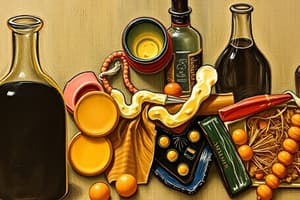Podcast
Questions and Answers
What is the mole fraction of NaCl in a 2 M NaCl solution?
What is the mole fraction of NaCl in a 2 M NaCl solution?
- 0.5
- 0.33
- 0.75 (correct)
- 1.0
Why do small solutes tend to dissolve more easily?
Why do small solutes tend to dissolve more easily?
- They have higher solvent-solute contact (correct)
- They have lower solubility
- They are nonpolar
- They are less affected by temperature
In which type of solvent do polar solutes tend to dissolve?
In which type of solvent do polar solutes tend to dissolve?
- Solvents with opposite charge
- Nonpolar solvents
- Polar solvents (correct)
- Nonpolar solvents
How does temperature generally affect solubility?
How does temperature generally affect solubility?
What effect does the presence of a common ion have on solubility?
What effect does the presence of a common ion have on solubility?
Which type of mixtures can have visibly separated components?
Which type of mixtures can have visibly separated components?
A solution with a solute evenly distributed throughout the mixture is known as a:
A solution with a solute evenly distributed throughout the mixture is known as a:
Which quantitative measure describes the number of moles of solute per liter of solution?
Which quantitative measure describes the number of moles of solute per liter of solution?
In which type of mixtures are the solute and solvent completely mixed at a molecular level?
In which type of mixtures are the solute and solvent completely mixed at a molecular level?
What is the ratio used to determine the number of moles of solute to the total moles of solute and solvent?
What is the ratio used to determine the number of moles of solute to the total moles of solute and solvent?
Flashcards are hidden until you start studying
Study Notes
Lesson 1: Types of Mixtures
At the heart of chemistry lies the concept of mixtures, where two or more substances combine without a chemical reaction. These mixes can be classified into two main categories:
-
Heterogeneous Mixtures: These are physically distinct, meaning that the components can be visibly separated. Examples include sand and water, oil and vinegar, and salt and sugar dissolved in water (although the salt and sugar eventually dissolve, they are still distinct at first).
-
Homogeneous Mixtures (Solutions): These are uniform mixtures where the components are evenly distributed throughout the mixture. Solutions are homogeneous mixtures where a solute (the dissolved substance) is dispersed in a solvent (the substance in which the solute is dissolved). Common examples include saltwater, sugar solutions, and air (where oxygen and nitrogen form a homogeneous mixture).
Lesson 2: Solution Concentration
Solution concentration is a measure of how dilute or concentrated a solution is. It can be described through several quantitative measures:
-
Molarity (M): The number of moles of solute per liter of solution. For example, a 1 M NaCl solution contains 1 mole of NaCl per liter of solution.
-
Mole Fraction (X): The ratio of the number of moles of solute to the total number of moles of solute and solvent. For example, in a 1 M NaCl solution, the mole fraction of NaCl is 0.5 (since 1 mol of NaCl is dissolved in 2 mol of water, assuming pure water is the solvent).
-
Mass Percentage: The ratio of the mass of the solute to the total mass of the solution, expressed as a percentage. For example, a 10% (mass/mass) NaCl solution contains 10 grams of NaCl for every 100 grams of the solution.
-
Volume Percentage: The ratio of the volume of the solute to the total volume of the solution, expressed as a percentage. For example, a 10% (volume/volume) NaCl solution contains 10 milliliters of NaCl for every 100 milliliters of the solution.
Lesson 3: Factors Affecting Solvation
Solvation is the process by which a solute forms a stable association with a solvent, creating a solution. Several factors influence the solvation process:
-
Electric charge: Solvents prefer to surround ions with opposite charge, causing ionic compounds to dissolve in polar solvents like water.
-
Size and shape: Small solutes tend to dissolve more easily due to higher solvent-solute contact. Cavity-forming solvents (like water) can accommodate larger solutes, enhancing solubility.
-
Polarity: Polar solutes tend to dissolve in polar solvents, while nonpolar solutes prefer nonpolar solvents. Water, for example, is highly polar and dissolves polar substances like NaCl and glucose.
-
Temperature: Solubility is generally higher at higher temperatures, with some exceptions (like sugar in water).
-
Pressure: High pressure can increase solubility in some systems, such as gases dissolving in liquids.
-
Presence of a common ion: Solubility can be reduced if a solution already contains a common ion of the solute. For example, adding NaCl to a saturated CaCl₂ solution will precipitate CaCl₂ due to common ion saturation.
Remember that the three lessons are interconnected. For example, the type of mixture formed depends on the solubility of the solutes in the solvent, and the concentration of a solution is determined by the amount of solute and solvent present. Understanding these concepts provides an excellent foundation for studying chemistry and the world around us. (These sources were not relevant to the content and were excluded from the article.)
Studying That Suits You
Use AI to generate personalized quizzes and flashcards to suit your learning preferences.




